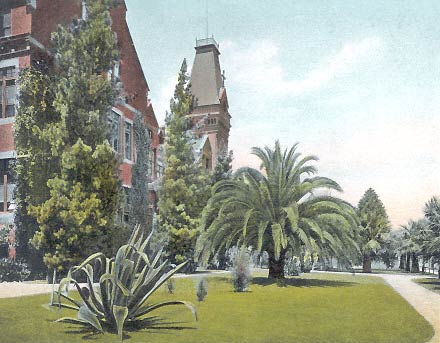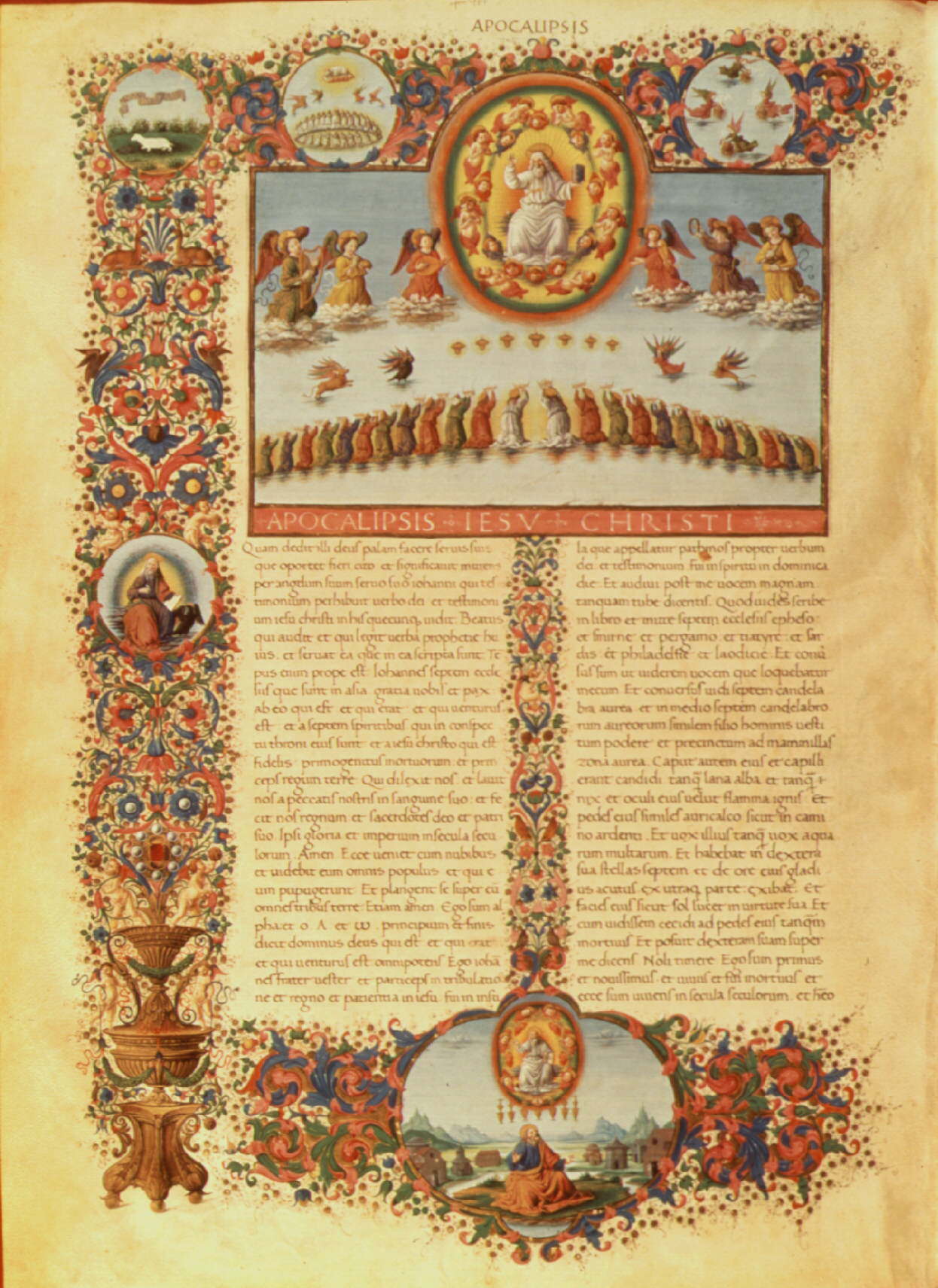 The School The City Forgot
The School The City ForgotDowntown's St. Vincent's College Was the First Higher-Learning Institution in Los Angeles
by Jay Berman
They studied Latin, Greek and philosophy, played baseball against teams from USC and Cal, and swam in a pool that was considered the best of its time. The second location of
St. Vincent's College was on Sixth Street between Hill and Broadway. The school was the first higher-learning institution in Los Angeles. One graduate became a Democratic Party stalwart who ran for the U.S. Senate, another was Los Angeles County's sheriff for 26 years, and a third was a beloved character actor and television pioneer. They were the boys and men of St. Vincent's College, long gone now but for half a century a major part of the educational picture of a young Los Angeles. It was the first high school and college in the city. Fifteen years before USC opened its doors in 1880, and about five miles north of what would become the Figueroa Street campus, a man named
Thaddeus Amat had an idea. Early in 1865, Amat, the first Catholic bishop of Southern California, organized a meeting at his home of as many community leaders as you might expect to find in a town of 5,000. His goal was to determine the feasibility of establishing a campus in the area. There was no high school in Los Angeles, let alone a college, and Amat thought there was a need. The group decided to proceed, and Don Vicente Lugo donated his adobe at the southeast corner of Los Angeles and Alameda streets in the plaza to be used as the first campus. Bishop Amat was a member of the Vincentian Order, and the
Vincentians sent some teachers to Los Angeles and opened St. Vincent's College - named for
St. Vincent de Paul, the founder of the organization - in August 1865. The founding of the University of California system was still three years away, and the opening of Los Angeles' first public school was 22 years in the future. The definition of a college in those days was far different than today. Neil Bethke, archivist at Loyola Marymount University, said Bishop Amat's initial goal was to establish a seminary for the training of future priests, as well as a school for poor children. The first class at St. Vincent's -
"probably no more than a dozen," according to Bethke - would have been boys of 13 or 14. As they reached college age, they would have taken classes appropriate for that educational level. St. Vincent's College became Loyola College - now Loyola Marymount University, with a main campus in Westchester - in 1918, but from 1865 until 1918, St. Vincent's students studied English grammar and composition, history, algebra, trigonometry, calculus, chemistry, Spanish, French and German. They played intercollegiate football and baseball and worked out in the campus gym.In its 53 years, St. Vincent's occupied four campuses, changed from Vincentian administration to Jesuit, and was briefly known as Los Angeles College when it was in transition between the two orders.
Its athletic teams regularly played USC, Whittier, Occidental and Cal. The baseball team, the school's most successful athletic program, even played the National League's New York Giants - today's San Francisco Giants - in three 1907 spring training games. At least five St. Vincent's grads went on to play in the major leagues. In those pre-Trojan days, USC athletic teams were usually called the Methodists in the city's newspapers, Occidental was known as the Presbyterians, and St. Vincent's athletes were frequently referred to in articles as the Catholic collegians, but also occasionally as the Saints. UCLA did not yet exist.
School on the Move St. Vincent's stayed at the Lugo adobe for two years. It moved in 1867 to a two-story, seven-room building on Sixth Street between Hill Street and Broadway. The state issued a charter to the school in 1869, which Bethke described as the equivalent of today's accreditation process. Bishop Amat died in 1878, when the city's population had reached 10,000. When the college next moved, the initial report of the transaction was buried in a May 25, 1886, Los Angeles Times City Council story below coverage of a change in water rates and discussion of a new reservoir. The cost of the land and building was $100,000. The following year, St. Vincent's College moved to the northwest corner of Grand Avenue and Washington Boulevard. The Sixth Street property eventually became the site of the first Bullock's department store. The Times of Jan. 2, 1887, in the flowery style of that time, said the school's
"stately walls and lofty towers" were rising and would soon be
"an ornament to the city, with much attention being paid to ventilation and sanitary measures." Another Times article three years later called the site
"centrally located in the residence portion of the city, within easy access by street cars from any point...." The halls and dormitories were described as
"lofty and spacious" with
"abundant space for games and outdoor recreation." The campus included a four-story classroom building, a chapel, a dormitory and a gymnasium. In 1901, when enrollment reached 120, a second dormitory was added as Rev. J.S. Glass, the new president, expected enrollment to rise to 200. Two years later, another article reported that St. Vincent's was
"enjoying a period of unprecedented prosperity," necessitating an addition to the main building. Why the success? A July 7, 1903, Times story had the answer:
"St. Vincent's gives a truly liberal education - education of mind and heart - an education that makes manly men - men fitted to work out the great problems of life." For a while, St. Vincent's was an athletic power. Francis Haggerty was brought in as director of physical training (today he would be called athletic director) in 1904, when there was only a baseball team. Haggerty established football and track teams and was there for the construction of a gym and a swimming facility. The gym had a running track of crushed granite, rather than the more customary cinder. The indoor swimming pool was 50 feet long. At that time, the school had an enrollment of 225. The school's first football team, in 1904, defeated Occidental and lost to Pomona. The 1905 team played scoreless ties with USC and Pomona, lost to Cal and Stanford, but hammered the University of Arizona, 54-0. In May 1907, Haggerty left to practice law.
Prominent GradsMany alumni went on to success. Among them were
Isidore Dockweiler,
Eugene Biscailuz and Leo Carrillo. Dockweiler received the first bachelor of arts degree awarded by St. Vincent's, in 1887. Four of his sons would later attend the college. Dockweiler, who became a member of the school's board of directors, passed the bar in 1889 and represented the school when it purchased the Venice Boulevard property. He became active in politics, serving on the Democratic National Committee from 1916 until 1932 and running unsuccessfully for the Senate. After his death in 1947, a three-mile stretch of beach at Playa del Rey was named for him. Biscailuz, who was descended from the city's founders, was sheriff of Los Angeles County from 1932 until 1958, 11 years before his death. Carrillo and Biscailuz were close friends. Carrillo, probably best known for his portrayal of Pancho on the
"Cisco Kid" television series in the 1950s, died in 1961 at the age of 80. He had been an early advocate of the preservation of Olvera Street, Pico House and what became the El Pueblo de Los Angeles Historical Monument.
George Herriman, another St. Vincent's alumnus, was a comic strip pioneer. From 1913 until his death in 1944, his
"Krazy Kat" appeared in newspapers throughout the country. Bill Watterson ("Calvin and Hobbes") and Charles Schulz ("Peanuts") listed him as an influence on their work. There were other prominent alumni. Ferde Grofé, a pianist and composer who worked as an arranger for other composers, including George Gershwin, wrote
"Grand Canyon Suite" in 1931. Fred Snodgrass, who was catching for the St. Vincent's baseball team in 1907, impressed New York Giants manager John McGraw and played in the major leagues from 1908 through 1916. William
"Dolly" Gray, another baseball player, was a star in the early years of the Pacific Coast League. He won 23 games for the Los Angeles Angels in 1903, the league's first year, and had 34 wins in 1907.
End of an EraSt. Vincent's - both the high school and the college - continued to operate at Washington and Grand until 1910, when the Vincentians decided to withdraw from the field of education in Los Angeles. A Feb. 25, 1911, Times story said Rev. Thomas Finney of the Vincentians had decided
"to withdraw his workers from collegiate work and put them back to labor among the missions, the seminaries and parochial work, the object for which this body of clergy was intended." Bishop Thomas Conaty then invited the Jesuit Order to take over operation of St. Vincent's. Bethke, the Loyola Marymount archivist, believes financial considerations likely also figured in their decision. The final commencement under the Vincentians took place June 14, 1911. A Times story the following day said the 46th annual commencement carried "a perceptible undertone of sadness" because of "a realization that this was the last commencement... under the auspices of St. Vincent's Brotherhood." At the time of that commencement, 40 diplomas were awarded, and the faculty numbered 24. "So here they were in 1911," Bethke said, "with Jesuits beginning to take over, but Vincentians were still on the board because they held the charter." The Jesuits sent a handful of teachers down from their California headquarters in Santa Clara, and the transition from St. Vincent's to Loyola began,
but not without a detour. The school was renamed Los Angeles College and was moved into several bungalows on Avenue 52 in Highland Park, but the site was inadequate from the start. There were no residence quarters, meaning students had to seek rooms in nearby houses. There was no auditorium, no laboratories for science classes, and the area was considered too far from Downtown Los Angeles. Until 1914, it was a college in name only, Bethke said, serving as a prep school.On Nov. 21, 1916, ground was broken for a campus on Venice Boulevard (then called 16th Street) between Vermont and Normandie avenues. News stories said the campus would house St. Vincent's College, but that would not be the case. The Jesuits now held the charter, and a Times story of March 22, 1918, led with this paragraph
:"St. Vincent's College, the first educational institution of its rank in Los Angeles, and from which many prominent business and professional men of this city have graduated, is to become only a memory. In its place is to stand... Loyola College... The change of name is to be officially announced today." The buildings at Washington and Grand were sold to the Los Angeles Athletic Club for $460,000 in 1922. That was the end of St. Vincent's College, although Bethke pointed out that, for many years, reunion invitations were sent to alumni of "Old St.Vincent's College and Loyola." Until 1929, the high school and college shared the Venice Boulevard campus. Loyola College was moved to its current Westchester site in 1929.
Marymount College, a women's Catholic school, moved to the Westchester campus of Loyola University in 1968. Loyola and Marymount merged in 1973, forming Loyola Marymount. It was the first time women had attended class at Loyola. During its 53 years, Bethke said St. Vincent's College probably graduated no more than 500 alumni.
"There were years," he said,
"when the graduating class was two or three people." Today's undergraduate enrollment at Loyola Marymount is nearly 6,000.
 The Archbishop of Canterbury kept a special communion service for gays so secret that he failed to tell the Bishop of London it was happening in his diocese, The Times has learnt.
The Archbishop of Canterbury kept a special communion service for gays so secret that he failed to tell the Bishop of London it was happening in his diocese, The Times has learnt.










 Dominican Jesuit priest Jose Luis Aleman dies in Santiago
Dominican Jesuit priest Jose Luis Aleman dies in Santiago















